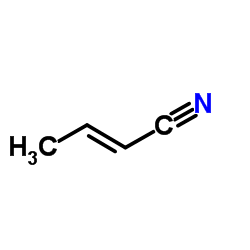2-丁烯腈
一般危化品

2-丁烯腈结构式
|
常用名 | 2-丁烯腈 | 英文名 | crotononitrile |
|---|---|---|---|---|
| CAS号 | 4786-20-3 | 分子量 | 67.089 | |
| 密度 | 0.8±0.1 g/cm3 | 沸点 | 120.5±0.0 °C at 760 mmHg | |
| 分子式 | C4H5N | 熔点 | -51.5ºC | |
| MSDS | 中文版 美版 | 闪点 | 20.0±0.0 °C | |
| 符号 |


GHS02, GHS07 |
信号词 | Danger |
| 中文名 | 2-丁烯腈 |
|---|---|
| 英文名 | 2-Butenenitrile |
| 中文别名 | 巴豆腈 |
| 英文别名 | 更多 |
| 密度 | 0.8±0.1 g/cm3 |
|---|---|
| 沸点 | 120.5±0.0 °C at 760 mmHg |
| 熔点 | -51.5ºC |
| 分子式 | C4H5N |
| 分子量 | 67.089 |
| 闪点 | 20.0±0.0 °C |
| 精确质量 | 67.042198 |
| PSA | 23.79000 |
| LogP | 0.71 |
| InChIKey | NKKMVIVFRUYPLQ-UHFFFAOYSA-N |
| SMILES | CC=CC#N |
| 外观性状 | 透明淡黄色液体 |
| 蒸汽压 | 15.2±0.2 mmHg at 25°C |
| 折射率 | 1.418 |
| 储存条件 | 常温,避光,通风干燥处,密封保存 |
| 稳定性 | 1. 常温常压下稳定。 2. 存在于烟气中。 |
| 分子结构 | 1、 摩尔折射率:20.55 2、 摩尔体积(cm3/mol):81.5 3、 等张比容(90.2K):186.7 4、 表面张力(dyne/cm):27.5 5、 极化率(10-24cm3):8.14 |
| 计算化学 | 1、 疏水参数计算参考值(XlogP):0.8 2、 氢键供体数量:0 3、 氢键受体数量:1 4、 可旋转化学键数量:0 5、 拓扑分子极性表面积(TPSA):23.8 6、 重原子数量:5 7、 表面电荷:0 8、 复杂度:72.9 9、 同位素原子数量:0 10、 确定原子立构中心数量:0 11、 不确定原子立构中心数量:0 12、 确定化学键立构中心数量:1 13、 不确定化学键立构中心数量:0 14、 共价键单元数量:1 |
| 更多 | 1. 性状:无色至淡黄色液体 2. 密度(g/mL,25°C):0.83 3. 相对蒸汽密度(g/mL,空气=1):不确定 4. 熔点(ºC):不确定 5. 沸点(ºC,常压):120-121 6. 沸点(ºC,715mmHg):不确定 7. 折射率(n20D):1.419 8. 闪点(ºC):17 9. 比旋光度(º):不确定 10. 自燃点或引燃温度(ºC):不确定 11. 蒸气压(kPa,25ºC):不确定 12. 饱和蒸气压(kPa,60ºC):不确定 13. 燃烧热(KJ/mol):不确定 14. 临界温度(ºC):不确定 15. 临界压力(KPa):不确定 16. 油水(辛醇/水)分配系数的对数值:不确定 17. 爆炸上限(%,V/V):不确定 18. 爆炸下限(%,V/V):不确定 19. 溶解性:溶于乙醚、丙酮 |
|
||||||||||||||||||||||||||||||||||||||||||||||||||||||||||||||||||||||||||||||||||||||||||||||||||||||||||||||||||||||||||||||||||||||||||||||||||||||||||||||||||||||||||||||||||||||||||||||||||||||||||||||||||||||||||||||||||||||||||||||||||||||||||||||||||||||||||||||||||
|
2-丁烯腈毒理学数据: 1、急性毒性:大鼠口径LD50:501mg/kg;小鼠口径LD50:396 mg/kg;兔子静脉TDLo:60mg/kg;豚鼠口径TD50:272mg/kg;豚鼠皮下LDLo:230mg/kg 2-丁烯腈生态学数据: 该物质对环境可能有危害,对水体应给予特别注意 |
| 符号 |


GHS02, GHS07 |
|---|---|
| 信号词 | Danger |
| 危害声明 | H225-H302-H315-H319-H335 |
| 警示性声明 | P210-P261-P305 + P351 + P338 |
| 个人防护装备 | Eyeshields;Faceshields;full-face respirator (US);Gloves;multi-purpose combination respirator cartridge (US);type ABEK (EN14387) respirator filter |
| 危害码 (欧洲) | Xn: Harmful;F: Flammable; |
| 风险声明 (欧洲) | R16;R26;R36/37/38 |
| 安全声明 (欧洲) | S16-S26-S36 |
| 危险品运输编码 | UN 2924 3/PG 2 |
| WGK德国 | 3 |
| RTECS号 | GQ6322000 |
| 包装等级 | II |
| 危险类别 | 3.1 |
|
Comparative developmental toxicities of aliphatic nitriles: in vivo and in vitro observations.
Toxicol. Appl. Pharmacol. 163(2) , 149-63, (2000) The effects on embryonic development of a series of eight saturated (acetonitrile, propionitrile, and n-butyronitrile) and unsaturated (acrylonitrile, methacrylonitrile, allylnitrile, cis-2-pentenenit... |
|
|
A new unifying hypothesis for lathyrism, konzo and tropical ataxic neuropathy: nitriles are the causative agents.
Food Chem. Toxicol. 49(3) , 563-70, (2011) Konzo and lathyrism are associated with consumption of cassava and grass pea, respectively. Cassava consumption has also been associated with a third disease, tropical ataxic neuropathy (TAN). This re... |
|
|
Relative developmental toxicities of inhaled aliphatic mononitriles in rats.
Fundam. Appl. Toxicol. 20(3) , 365-75, (1993) The developmental toxicities of eight aliphatic mononitriles were studied in Sprague-Dawley rats after inhalation exposure for 6 hr/day, during Days 6 to 20 of gestation. The range of exposure concent... |
| EINECS 225-335-1 |
| (2E)-2-Butenenitrile |
| (2E)-But-2-enenitrile |
| Crotononitrile (pract) |
| MFCD00001935 |
| cis-β-Methylacrylonitrile |
| (E)-2-Butenenitrile |
| crotononitrile |
| But-2-Enenitrile |
| 2-Butenenitrile, (2E)- |